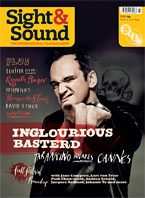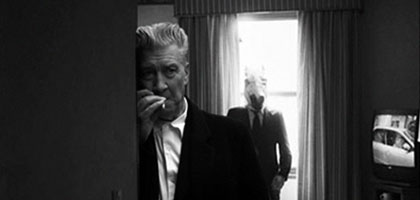Primary navigation


David Lynch's new music collaboration sees him use singing and photography in his continued exposing of the dark psyche of suburbia. He talks to James Bell
As those who have followed director David Lynch throughout his career will know, film-making has only ever made up part of his working life. Painting, photography, animation and music are all areas he has worked in. Far from being the side projects of a dilettante, Lynch has approached each with the same singular vision that marks his film-making.
Lynch's latest 'side' project was initiated by an invitation from the American music producer Danger Mouse. He asked Lynch to shoot a series of photographs to accompany an album he was working on with the songwriter Mark Linkous, aka Sparklehorse, which would be published in a book released with the record. Danger Mouse and Sparklehorse composed the music for an album's worth of songs and then enlisted different singers to perform on and write lyrics for each track, including Iggy Pop, Julian Casablancas of The Strokes, Gruff Rhys of the Super Furry Animals, Wayne Coyne of The Flaming Lips and, to his own initial surprise, David Lynch himself.
“Well, here's how it happened,” Lynch explains by phone from his home in the Hollywood Hills. “Danger Mouse told me that he had been working on this album with Sparklehorse and asked if I could do some still photos for it. I thought that was a cool concept. As he was leaving I said jokingly, 'You know, I thought you might be coming up here to ask me to sing.' I thought he would laugh, but he said, 'No, no, no, I want you to sing on a track.' So he started playing me tracks that didn't have anybody on them, one of them stood out, and that was the song 'Dark Night of the Soul'.”
Lynch had worked successfully on music in the past, among other projects writing lyrics for singer Julee Cruise for her two albums he co-produced with his regular composer Angelo Badalamenti in the early 1990s. But he has only recently begun to sing himself; the first time was on songs included on the Inland Empire (2006) soundtrack. Of the two songs he sings on the new album, 'Star Eyes (I Can't Catch It)' and 'Dark Night of the Soul', he says: “It was really a thrill. I am working on new music. I'm not a musician, but I play music. I started doing it just to make sounds, experimental sounds, and it's led to something. When you see real musicians and what some of them can do, it's mind-blowing; I love being in that world, it's just a thrill. Musicians depend on others, it's truly like a bonding, unity thing. It's magical.”
'Dark Night of the Soul' is sung by Lynch in a tremulous voice - imagine his distinctive speaking voice, with its unusual vowels, sung in a shy, higher pitch and you're getting close. The track gives the record its title, capturing the overall mood of the album. Although the different singers worked entirely independently of one another, all the songs ultimately seem thematically linked by suggesting a troubling, nightmarish - and typically Lynchian - journey through an urban night.
Lynch conceived the ideas for the three or four photographs that would accompany each song; all of the pictures in the book were shot especially for the project. As ever with Lynch, the initial process involved him 'fishing' for the ideas swimming around him. “I'd just sit and listen to those songs, images would come and I'd write those things down. And then Danger Mouse and his bunch and me and my crew, we organised two days of shooting, just like going out and shooting a film, but it was going out and shooting stills - that was a blast, such a great two days.”
The shots were all taken around Los Angeles, with Danger Mouse effectively acting as the producer: booking studios, securing locations, hiring actors. The shots are all immediately recognisable as Lynch's work; many could be stills from an unseen, as yet unmade Lynch film that you conjure in your mind as you look at them. “That's true,” agrees Lynch. “There is a narrative to each series, to each song. When you look at a series of still images, a story just comes out. Some people could be looking at them and listening to the music at the same time, and in their mind they've got a whole scene, or a whole sequence of scenes.”
One series begins with a shot of a couple embracing on a front lawn, before the next two shots show a bedroom with a bedside table covered with bottles of pills, suggesting dark secrets behind an outwardly happy and secure American life. Figures are often shot with stark light, as though caught emerging from the black night behind them. Francis Bacon is explicitly evoked in a number of shots of ghostly, distorted faces. In another series a blonde girl in a vintage dress is standing on a lawn tending a barbecue while flames - another familiar Lynchian element - lick against the black background. When pushed for an explanation of the themes behind some of the shots, Lynch - who famously hates analysing his work in interviews for fear of pulling the enigmatic, dreamlike ideas back to a more prosaic interpretation - replies only how “magical” the light was that day, or how excited he was by the possibilities afforded by his new digital camera, a Hasselblad 39 million pixels HD3.
These mysterious images feel like the kernels of ideas to be developed by Lynch in films in the future - he has after all used his work in other fields as 'sketches' for films throughout his career, especially in recent years. The website he founded in 1999 has hosted short films, animation and short documentaries showing him at work. (Many of these are collected on the forthcoming UK DVD release of the Dynamic (01) collection. Lynch can also be seen at work on Inland Empire and other projects in the documentary Lynch (one), available on UK DVD this month.) Inland Empire was full of ideas initially seen on his website, from the Rabbits sequences to the influence of some of the characters and scenarios of his crudely animated, blackly comic Dumbland series, which follows a violent husband as he is irritated by modern life and terrorises his family and neighbours.
“Getting films up on the internet gives the opportunity for a continuing story, which is pretty thrilling,” he says, “but it does take a lot of focus and time, even with this sped-up digital world. For a continuing story you'd have to have a great team and all the ideas written - it would be a big deal.”
I ask Lynch if he is excited by new 3D technology. “You bet, for sure. I did a 3D thing for Cartier at the dome at Art Basel in Miami, and that was a thrill. 3D projection on a dome! When I saw the dome's technology I thought, there's a future in that, you know, 'domes in homes'! The possibilities are cosmic. I've seen these 3D monitors - I'm going to use a couple of them in a project in Paris - where there are eight different viewing points, but it's 3D; some things seem to shoot out seven or eight feet from the television. It's incredible.”
Could this change the way he tells stories? “Every medium talks to you a different way, so 3D will start talking to you, but you've got to get into that world, see it and feel it - then ideas will start coming that would find a home in the 3D world.”
Though he has always been an outsider, at this stage in his career Lynch seems further than ever from mainstream American film-making, and doesn't even entertain the idea that his next feature could be made in the US. Mulholland Dr. (2001) was rescued by money from the French company StudioCanal, which also funded Inland Empire, and Lynch seems resigned to having to look to Europe for sympathetic backers for his next feature, whenever that might come. “The American studios are great, and they do what they do,” he says. “But their thinking is not correct, in my mind. When the bottom line is money it's just kind of sadness and heartache. In France particularly there's a whole different take on it, and I like that so much.” Much of Inland Empire was shot in Poland, and Lynch says he can imagine shooting at least part of his next feature there: “I love to work in Poland. I'm involved in a big project in Lodz; it's a giant electrical plant that we've converted into a studio for all kinds of things, from painting to theatre, music, film-editing rooms, workshops, welding… all kinds of things for artists in that area, and you bet it's somewhere I'll work myself.”
NB The day after I talk to Lynch, there is an announcement that owing to a legal dispute with EMI, the 'Dark Night of the Soul' album won't be released. Instead the book will come with a blank CD-R, an “artefact to use however you see fit” - implying that the music could be downloaded for free from a website hosting it.
The book 'Dark Night of the Soul' is available now. The DVDs of 'Dumbland' and 'Lynch (one)' are available this month from Scanbox Entertainment. 'Dynamic (01)' will be released in September.